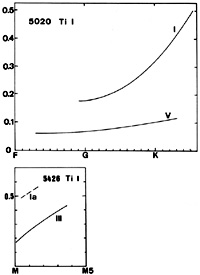
This element was discovered independently by W. Gregor in Creed, England in 1791 and by M. Klaproth in Berlin in 1795. The name alludes to the Titans, giants in Greek mythology.
Ionization energies
TiI 6.8 eV, TiII 13.6 eV, TiIII 27.5 eV.
Ti is a well-represented element in stellar spectra. In the sun it figures in third place as far as the number of lines is concerned.
Absorption lines of TiI
| 3998(12) | 5020(38) | ||||
| Group | V | I | V | III | Ib |
| F0 | 0.13 | 0.223(Ia) | |||
| F2 | 0.251(Ib) | ||||
| F4 | 0.06 | ||||
| F6 | 0.06 | ||||
| F8 | 0.06 | ||||
| G0 | 0.17 | ||||
| G1 | 0.11 | ||||
| G2 | 0.14 | ||||
| S | 0.110 | ||||
| G5 | 0.20 | 0.09 | 0.224 | ||
| K0 | 0.10 | 0.128 | |||
| K2 | 0.10 | 0.28,0.41 | |||
| K5 | 0.48 | ||||
| 5300(74) | 5367(35) | 5426(3) | ||||
| Group | V | III | V | III | III | I |
| S | 0.021 | 0.002 | ||||
| K0 | 0.060 | |||||
| K2 | 0.077 | |||||
| K3 | 0.132 | |||||
| M0 | 0.177 | 0.18 | ||||
| M2 | 0.53(Ia) | |||||
| M2.5 | 0.224 | |||||
| M3 | 0.30 | |||||
| M4 | 0.28 | |||||
| M5 | 0.34 | 0.38(Ib) | ||||
| M7 | (0.44) | |||||
TiI (see for instance the line at 5020) appears in late A-type stars and grows continuously toward later types. A positive luminosity effect exists. The most intense infrared line of TiI is that at 9638(32), which in the sun has W = 0.019.
 |
Absorption lines of TiII
| 4300(41) | 4563(50) | ||||
| Group | V | Ib | V | III | Ib |
| B5 | 0.01 | ||||
| B7 | 0.005 | ||||
| B9 | 0.08 | ||||
| B9.5 | 0.042 | ||||
| A0 | 0.09 | 0.16 | |||
| A1 | 0.11 | 0.084 | |||
| A2 | 0.16 | 0.096 | 0.563(0) | ||
| A3 | 0.18 | ||||
| A7 | 0.19 | 0.19 | |||
| F0 | 0.34 | 0.22 | 0.27(II) | 0.692(Ia) | |
| F2 | 0.524 | ||||
| F4 | 0.23 | ||||
| F5 | 0.27 | 0.19 | 0.42 | ||
| F6 | 0.19 | ||||
| F8 | 0.15 | 0.54 | |||
| GO | 0.14 | ||||
| G1 | 0.21 | ||||
| G2 | 0.12 | ||||
| S | 0.166 | 0.120 | |||
| G5 | 0.18 | ||||
| G8 | 0.16(1V) | ||||
| K0 | 0.19 | 0.21(III) | |||
| K2 | 0.16 | ||||
| K5 | 0.16 | ||||
| 5185(86) | 5337(69) | |||||
| Group | V | III | Ib | V | III | |
| G0 | 0.25 | |||||
| G1 | 0.224,0.273 | |||||
| S | 0.058 | 0.071 | ||||
| G2 | 0.19 | |||||
| G5 | 0.19,0.194 | |||||
| G8 | 0.077(IV) | 0.220 | 0.091 | |||
| K0 | 0.097 | 0.118 | ||||
| K2 | 0.097 | 0.16,0.254 | ||||
| K3 | 0.135 | |||||
| K5 | 0.18,0.263 | |||||
| M0 | 0.17 | |||||
| M2 | 0.346 | |||||
TiII (see the lines at 4300 and 4563) appears in mid-B-type and increases toward a flat maximum for F-type, although the lines persist up to type M. There is a strong positive luminosity effect.
 |
The resonance line is at 3349(1).
 |
Emission lines of Till
Several multiples of Ti II are seen in emission in T Tau stars Joy
1945). In long-period variables, the lines at 3759-61(13) appear
in emission near maximum (Merrill 1947) and in R CrB stars (Merrill
l951b). Weak emissions occur frequently in stars that present strong
emission lines of Fe II, for instance B[e] stars (Allen and Swings
1976).
Behavior in non-normal stars
TiII lines are frequently strong in shell spectra.
Ti III is present in at least one Ap star (Bidelman 1966).
In the lambda Boo stars, Ti II lines are weaker than in normal stars by factors of about two (Venn and Lambert 1990).
Ti has been found to be slightly overabundant with respect to Fe in metal-weak stars (Magain 1989), by a factor of the order of two, and this also seems to be the case for globular cluster stars (Wheeler et al. 1989, Francois 1991).
Strong TiII absorption lines appear in the spectra of supernovae of class II (Branch 1990).
Isotopes
Ti has five stable isotopes, namely Ti46, 47, 48, 49 and 50, and four
short-lived ones. In the solar system the frequencies of the stable
isotopes are respectively 8%, 7%, 74%, 5% and 5%.
Clegg et al. (1979) have investigated the relative frequency of the isotopes through an analysis of the TiO molecular bands, using the gamma (0,0) lines in the region around 7070. They examined a sample of 11 1ate (> K5) dwarfs and giants, including a few MS and one Sstar. The relative abundance of the isotopes seems to be solar. This confirms the earlier conclusion of Herbig (1948) of there being a solar-type distribution of isotopes in M-type stars.
Origin
Ti 46, 47, 48 and 49 are produced by explosive nucleosynthesis, whereas
Ti50 arises from the nuclear statistical equilibrium process.
Published in "The Behavior of Chemical Elements in Stars", Carlos Jaschek and Mercedes Jaschek, 1995, Cambridge University Press.